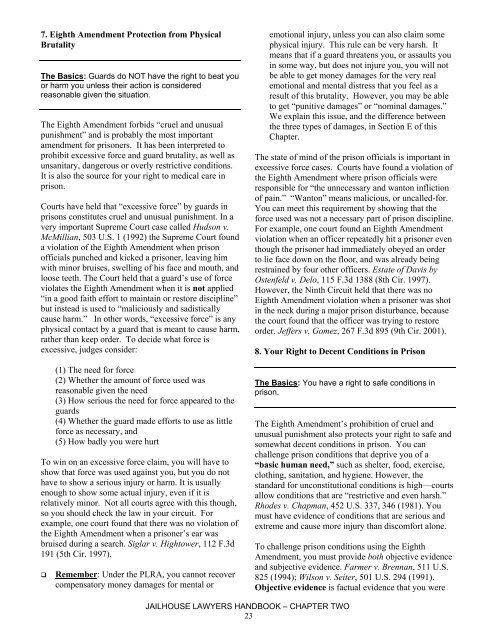Jailhouse Lawyer's Handbook - Sentencing and Justice Reform ...
Jailhouse Lawyer's Handbook - Sentencing and Justice Reform ...
Jailhouse Lawyer's Handbook - Sentencing and Justice Reform ...
Create successful ePaper yourself
Turn your PDF publications into a flip-book with our unique Google optimized e-Paper software.
7. Eighth Amendment Protection from Physical<br />
Brutality<br />
The Basics: Guards do NOT have the right to beat you<br />
or harm you unless their action is considered<br />
reasonable given the situation.<br />
The Eighth Amendment forbids “cruel <strong>and</strong> unusual<br />
punishment” <strong>and</strong> is probably the most important<br />
amendment for prisoners. It has been interpreted to<br />
prohibit excessive force <strong>and</strong> guard brutality, as well as<br />
unsanitary, dangerous or overly restrictive conditions.<br />
It is also the source for your right to medical care in<br />
prison.<br />
Courts have held that “excessive force” by guards in<br />
prisons constitutes cruel <strong>and</strong> unusual punishment. In a<br />
very important Supreme Court case called Hudson v.<br />
McMillian, 503 U.S. 1 (1992) the Supreme Court found<br />
a violation of the Eighth Amendment when prison<br />
officials punched <strong>and</strong> kicked a prisoner, leaving him<br />
with minor bruises, swelling of his face <strong>and</strong> mouth, <strong>and</strong><br />
loose teeth. The Court held that a guard’s use of force<br />
violates the Eighth Amendment when it is not applied<br />
“in a good faith effort to maintain or restore discipline”<br />
but instead is used to “maliciously <strong>and</strong> sadistically<br />
cause harm.” In other words, “excessive force” is any<br />
physical contact by a guard that is meant to cause harm,<br />
rather than keep order. To decide what force is<br />
excessive, judges consider:<br />
(1) The need for force<br />
(2) Whether the amount of force used was<br />
reasonable given the need<br />
(3) How serious the need for force appeared to the<br />
guards<br />
(4) Whether the guard made efforts to use as little<br />
force as necessary, <strong>and</strong><br />
(5) How badly you were hurt<br />
To win on an excessive force claim, you will have to<br />
show that force was used against you, but you do not<br />
have to show a serious injury or harm. It is usually<br />
enough to show some actual injury, even if it is<br />
relatively minor. Not all courts agree with this though,<br />
so you should check the law in your circuit. For<br />
example, one court found that there was no violation of<br />
the Eighth Amendment when a prisoner’s ear was<br />
bruised during a search. Siglar v. Hightower, 112 F.3d<br />
191 (5th Cir. 1997).<br />
<br />
Remember: Under the PLRA, you cannot recover<br />
compensatory money damages for mental or<br />
emotional injury, unless you can also claim some<br />
physical injury. This rule can be very harsh. It<br />
means that if a guard threatens you, or assaults you<br />
in some way, but does not injure you, you will not<br />
be able to get money damages for the very real<br />
emotional <strong>and</strong> mental distress that you feel as a<br />
result of this brutality. However, you may be able<br />
to get “punitive damages” or “nominal damages.”<br />
We explain this issue, <strong>and</strong> the difference between<br />
the three types of damages, in Section E of this<br />
Chapter.<br />
The state of mind of the prison officials is important in<br />
excessive force cases. Courts have found a violation of<br />
the Eighth Amendment where prison officials were<br />
responsible for “the unnecessary <strong>and</strong> wanton infliction<br />
of pain.” “Wanton” means malicious, or uncalled-for.<br />
You can meet this requirement by showing that the<br />
force used was not a necessary part of prison discipline.<br />
For example, one court found an Eighth Amendment<br />
violation when an officer repeatedly hit a prisoner even<br />
though the prisoner had immediately obeyed an order<br />
to lie face down on the floor, <strong>and</strong> was already being<br />
restrained by four other officers. Estate of Davis by<br />
Ostenfeld v. Delo, 115 F.3d 1388 (8th Cir. 1997).<br />
However, the Ninth Circuit held that there was no<br />
Eighth Amendment violation when a prisoner was shot<br />
in the neck during a major prison disturbance, because<br />
the court found that the officer was trying to restore<br />
order. Jeffers v. Gomez, 267 F.3d 895 (9th Cir. 2001).<br />
8. Your Right to Decent Conditions in Prison<br />
The Basics: You have a right to safe conditions in<br />
prison.<br />
The Eighth Amendment’s prohibition of cruel <strong>and</strong><br />
unusual punishment also protects your right to safe <strong>and</strong><br />
somewhat decent conditions in prison. You can<br />
challenge prison conditions that deprive you of a<br />
“basic human need,” such as shelter, food, exercise,<br />
clothing, sanitation, <strong>and</strong> hygiene. However, the<br />
st<strong>and</strong>ard for unconstitutional conditions is high—courts<br />
allow conditions that are “restrictive <strong>and</strong> even harsh.”<br />
Rhodes v. Chapman, 452 U.S. 337, 346 (1981). You<br />
must have evidence of conditions that are serious <strong>and</strong><br />
extreme <strong>and</strong> cause more injury than discomfort alone.<br />
To challenge prison conditions using the Eighth<br />
Amendment, you must provide both objective evidence<br />
<strong>and</strong> subjective evidence. Farmer v. Brennan, 511 U.S.<br />
825 (1994); Wilson v. Seiter, 501 U.S. 294 (1991).<br />
Objective evidence is factual evidence that you were<br />
JAILHOUSE LAWYERS HANDBOOK – CHAPTER TWO<br />
23





